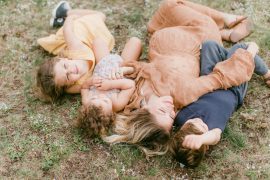Wear your baby
When you need to get things done or get out of the house, do what parents have been doing for thousands of years – wear your baby. There are many wonderful babywearing options available today, from wraps to slings to structured carriers.
Babywearing International (BWI) has great information on choosing a carrier and there may be a chapter near you where you can meet other parents and try out carriers. Here is their excellent graphic on safe babywearing.
To save money, you can check online for ways to make one yourself or look for used carriers at consignment sales or swap meets (be sure to check for any manufacturer recalls). A simple piece of fabric tied different ways was the first baby carrier and continues to be used around the world.
If you are separated from your baby for long periods due to outside employment or school, try to reconnect by cuddling and wearing your infant when you reunite.
As your child gets older, back carriers can be great for making dinner while keeping baby close.
Make baby holding a job
If you have a partner, discuss the importance of baby holding with them. Agree to take turns holding the baby (after a feed, of course) when the other needs a break or to make a quick dinner. Infants normally bond to one parent, particularly if that parent is breastfeeding, so the partner can either take over the task or try putting baby in a carrier and going for a walk.
If you are a single parent, think about friends who might be willing to come over and hold your baby for an hour or so every day or two. If needed, try to find a daycare situation with a caregiver who believes in baby holding and carrying.
Use baby buckets judiciously
In our culture, we all need to use baby buckets occasionally. Driving to the store or work or support group, baby has to be in a car seat. A bouncy seat comes in handy when a parent needs to scoop the cat box or grab a quick shower. Strollers can be wonderful for fresh air and exercise when baby is older and heavier.
Buckets have a purpose, but leaving an infant in one for extended periods of time deprives baby of biologically normal stimulation.
If used for naps, any baby holder (a blanket on the floor works too) should be kept in the same room as an adult, according to the American Academy of Pediatrics. Infants tolerate everyday light and noise quite well while sleeping. This sensory input, combined with an adult’s presence, can even reduce the risk of SIDS.
After my first child taught me what babies need, I kept on holding and carrying my other babies. It was overwhelming at times, but I was lucky to have a supportive partner and a mother who lived nearby.
I also found a tribe of like-minded parents who reassured me that this intense time of meeting my babies’ needs wouldn’t spoil them or last forever. And they were right. Babies need human bodies, not buckets.
Originally published here.
Mary Francell is a board certified lactation consultant (IBCLC) in private practice in Washington state, USA. She and her husband are the parents of three grown children. Mary founded and administers the Biologically Normal Infant Sleep group on Facebook and is an occasional guest host on the Untaming podcast. She has been a La Leche League Leader for over 25 years and currently serves as the Associate Area Professional Liaison for LLL of Washington state. Find out more on her website whatdobabiesneed.com and follow her on Facebook.










